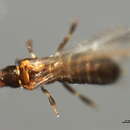Associations
(
Inglês
)
fornecido por BioImages, the virtual fieldguide, UK
In Great Britain and/or Ireland:
Foodplant / feeds on
larva of Thrips vulgatissimus feeds on pollen of Magnoliopsida
Remarks: season: 5-9
Foodplant / feeds on
larva of Thrips vulgatissimus feeds on live flower of Brassica napus ssp oleifera
Conservation Status
fornecido por University of Alberta Museums
May be a pest of canola (Burgess and Weegar 1988).
- licença
- cc-by-nc
- direitos autorais
- University of Alberta Museums
Cyclicity
fornecido por University of Alberta Museums
Undocumented.
- licença
- cc-by-nc
- direitos autorais
- University of Alberta Museums
Distribution
fornecido por University of Alberta Museums
Alberta, Newfoundland, Nova Scotia, Quebec, Ontario, Saskatchewan, B.C. N.W.T. Greenland (Chiasson 1986), U.S., Europe, and the former U.S.S.R. (Nakahara 1994).
- licença
- cc-by-nc
- direitos autorais
- University of Alberta Museums
General Description
fornecido por University of Alberta Museums
Body varies around 1.2 to 1.8mm in length and is dark brown. The foretibiae are yellow apically and basally. The forewings are pale and sometimes shaded with gray beyond the wing base and at the apex. The antennae are brown while the apex of segment 2, all of segment 3, and the base of segment 4 are yellow. The head is broader than long and the cheeks are strongly arched. Ocellar setae pair 3 is posterolaterad of the anterior ocellus and the antennae are 8 segmented. The pronotum is covered with transverse anastamosing lines of sculpture, and has 3 pairs of posteromarginal setae. There are 2 anteromedial campaniform sensilla present on the mesonotum, and 2 campaniform sensilla (occasionally 1 or none) on the metanotum. The forewing has 3 distal setae (occasionally 4 or 2) on the forevein. Tergite 2 has 3 lateral setae. Tergite 8 has a complete posteromarginal comb in which the microtrichia are closely set, but irregular in length. Tergite 9 has 2 pairs of campaniform sensilla. Abdominal sternites 6 and 7 each have 1 to 3 accessory setae. On males, the glandular areas on sternites 3 to 7 are transversely elongate (Nakahara 1994).
- licença
- cc-by-nc
- direitos autorais
- University of Alberta Museums
Habitat
fornecido por University of Alberta Museums
Polyphagous; and commonly on Taraxacum officinale, Salix.
- licença
- cc-by-nc
- direitos autorais
- University of Alberta Museums
Life Cycle
fornecido por University of Alberta Museums
This species prefers to breed in white flowers (Moritz et al 2001).
- licença
- cc-by-nc
- direitos autorais
- University of Alberta Museums
Trophic Strategy
fornecido por University of Alberta Museums
Undocumented.
- licença
- cc-by-nc
- direitos autorais
- University of Alberta Museums

